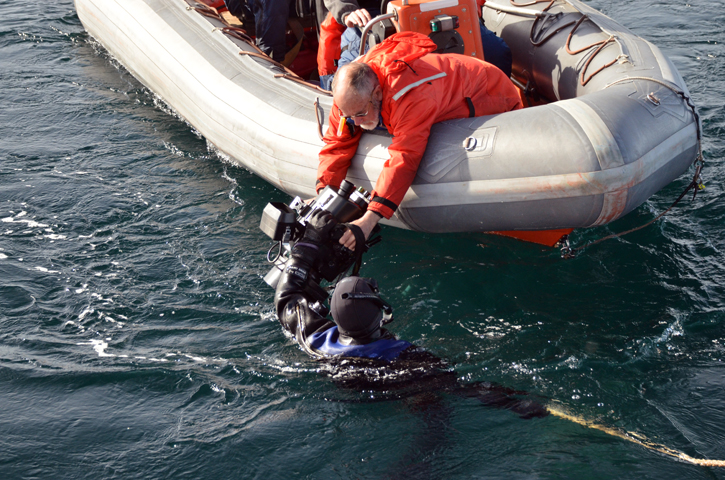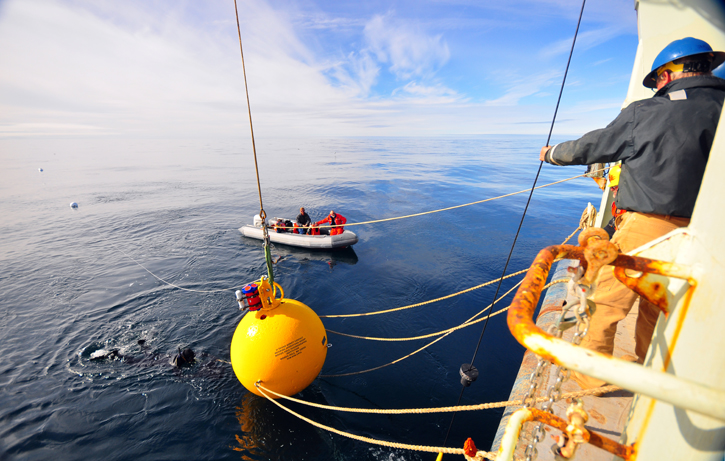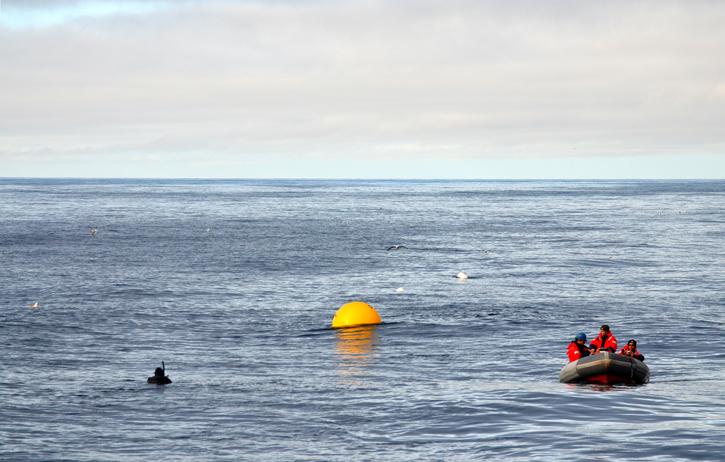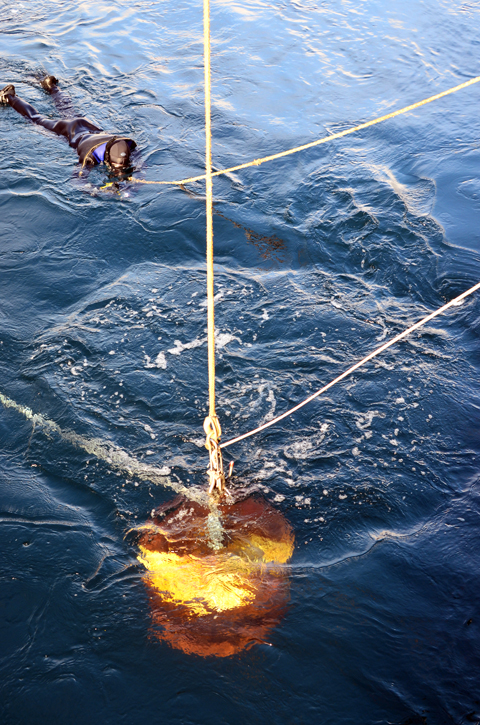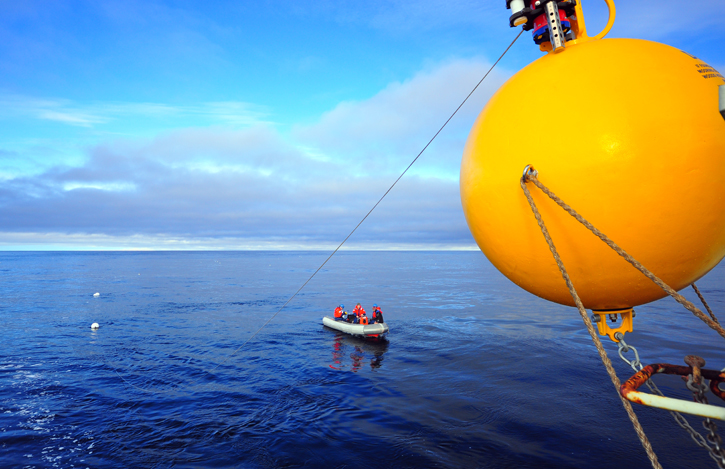August 25, 2011“Want to go for a boat ride?” asked Captain Sheasley. “Sure.” “Then grab a Mustang suit and come on.” The deck crew, with the sure-handed seamanship typical to this vessel, craned the small boat (a rigid-hull inflatable, or “RHIB”) off the 0-2 deck, lowered it to main deck and secured it to the starboard rail for ease of boarding. The purpose of this trip was photography. Rob McGregor is shooting footage for a multi-part National Geographic special about the ocean, and Sindre Skrede is shooting for a couple of Norwegian websites. They were not playing. Captain Sheasley, “ the Skip,” would drive the boat; he was sort of playing. Along for the ride, utterly superfluous, I was playing.
It’s always interesting to observe the direct relationship between the weather and the general mood aboard ships and boats at sea. The weather yesterday was exquisite, high-latitude perfection. The wind was slack, the sea dead flat except for long, gently undulating swells out of the east. The sky was blue and cloudless except for a non-threatening, half-formed front away to the west just dark enough to offer pleasing contrast. It looked like the gentle tropics if you ignored the jackets and wool hats and the Greenland iceberg floating on the horizon. (The Skip tells me that the new crew, having heard repeatedly the stories of warlike violence from the 2008 trip, is beginning to doubt our veracity.)
© Rachel Fletcher Jim, John, and Dan Torres, the hotshot WHOI mooring team, Kyle, the bosun, with Co-Principal Investigator (PI) Kjetil Våge, were assembling and deploying another mooring with their usual skilled choreography as we climbed aboard the RHIB. The crane operator lowered us into the water. Rob was geared up in his dry suit and fins, planning to shoot the mooring ops from in the water (temperature, 1.7° C., 35° F). Not a common event on research ships, this attracted attention from a bevy of scientists, off-duty techs and crew lining the transom peering through camera lenses. It bespoke tourism. “Everybody hanging on?” asked the Skip. We were. He put the hammer down and we sped away astern toward the mooring ball bobbing in the swells. By the typical deployment process, the big top float, loaded with an ADCP and miniature CTD to measure temperature and salinity, goes overboard first, and as the techs add the appropriate instruments one by one to the wire, they pay out the ever-lengthening mooring. The ship steams ahead at about one knot to keep the ball and the wire streaming straight aft, and the procedure continues until all the instruments have been attached. Finally, the two-ton anchor is splashed overboard. Rob wanted shots of the ball in the water and especially of the anchor going in. He rolled off the boat when we reached the top float, and I passed him his extremely heavy camera. The water, which looks flat black from aboard ship, was gin clear—alluring, if only it weren’t a tick or two above freezing. He had to swim hard to keep up with the float. It looked like work. We all respect the guy for his intrepid work and the Skip for his willingness to help him do it.
This cruise has attracted an unusual lot of attention from outside the professional community. There have been reports from Reuters and other public media in addition to National Geographic. This is in part because there is an element of exploration to it. Once the moorings have been laid across the Denmark Strait, we’ll strike off in search of the origins of that newly discovered current, which the co-PIs believe delivers half of the water flowing into the strait. Their hypothesis is that its origin lies out to the north- northeast. But does it? And if so, how far? As I mentioned yesterday, the circulation in this region is dizzyingly complex and confusing. As Bob reminds us, their hypothesis could be flat wrong. That’s why they call it exploration. Rob came back aboard the RHIB and we took a couple of fast spins around the ship to get some establishing shots for him and Sindre. “Captain, when we get close to Iceland….” “Yes?” “Can I get up on an iceberg?” Rob asked. “Uh, that’s a no.” We laughed and did a couple of riffs on how the Skip would explain it to his employers ashore if Rob came to grief. “Now let me get this straight, Captain Sheasley. You put a visitor on an…iceberg?” “Do you know anything about farming, Skip?” Chief Mate Adam Seamans called him from the bridge on the VHF. “We’re five minutes to station.” So we headed for the stern, lined with waiting spectators, to shoot the anchor deployment. The mooring streamed back from the ship 750 meters to the top float. Rob rolled into the water and hung onto a line from the transom as the ship dragged him along at a full knot. I passed the big camera down to him. It must have felt like an anvil in the rush of water. We followed in the boat.“One hundred meters from station,” Kyle the bosun called down to us. They hoisted the 2,200-pound anchor off the deck and ran it out over the water. Rob was getting tired hanging on. Who wouldn’t? “Fifty meters,” Kyle called. “Must be the longest hundred meters of his life,” the Skip observed. Cameras went up before every face on the transom. Additional flotation to keep the wire vertical was rigged just above the acoustic release in the form of basketball-sized glass spheres covered with stout yellow plastic jackets. Called “hard hats,” there were twelve of them bolted to the wire. It seemed to take forever before—“We’re here.”
© Rachel Fletcher John yanked the trip line and the anchor vanished. The hard hats plunged down after it in a burst of spray. In the distance, we could see the big top float water skiing on the surface back toward the ship before it was dragged under. Rob was half-frozen. He said he was feeling “chill blanes” after he climbed aboard and we headed back to the starboard side for pick up. That evening about eight of us stood at the portside rail like tourists to revel in a fine sunset shinning on low, light-gray clouds above a white bank of fog. There’s no place like the high northern latitudes and at that moment no place we’d rather have been. We said so more than once before we got too cold to remain topside.
Last updated: December 27, 2011 | ||||||||||||||||
Copyright ©2007 Woods Hole Oceanographic Institution, All Rights Reserved, Privacy Policy. | ||||||||||||||||


